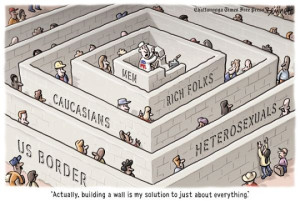Investors Pessimistic Over Stock Market
Investors Pessimistic Over Stock Market

Investors hate stocks — again.
Amid a six-year bull market that’s notable mainly for how little conviction there is in it, equity sentiment is plunging at a historic rate, falling by some measures at the fastest pace since Federal Reserve Chairman Paul Volcker had just finished pushing up interest rates in the 1980s. The cost to hedge against stock losses is soaring, valuations are contracting, and bearishness among professional stock handicappers is rising the most in three decades.

Fret not. All of this is good news for bulls, if history is any guide. Since 1963, the Standard & Poor’s 500 Index has advanced an average 11 per cent in the year after newsletter writers surveyed by Investors Intelligence were as pessimistic as they are now, data compiled by Bloomberg show. That compares with an annualized return of 8.3 per cent.
S&P 500 futures expiring in December rose 0.2 per cent at 10:32 a.m. in London.
This is the least-believed economic recovery and the least-believed bull market of our careers
Skepticism is one thing the rally since 2009 hasn’t lacked — and it may be the best thing stocks have going for them as corporate profits fall, concerns deepen over China’s travails, oil and commodities plunge and the Fed turns more pessimistic on global growth. Some traders even say they see bargains after S&P 500 posted its first 10 per cent retreat in four years.
‘Least-Believed’
“This is the least-believed economic recovery and the least-believed bull market of our careers,” said Bob Doll, chief equity strategist at Chicago-based Nuveen Asset Management, which oversees US$130 billion and bought stocks during the August selloff. “The nervousness means people have stepped to the sidelines. The question is, who is left to sell? Everybody who has cash is a potential buyer.”
Investors have bailed out of stocks at every sign of trouble since 2009, from the euro crisis to ebola, with the latest catalyst coming from China’s devaluation of its currency. The distrust has been a barrier to euphoria, a quality that historically is the bigger threat to bull markets.
Fear reigns, spreading faster than any time since 1984 as the S&P 500 tumbled 10 per cent over four days in August. At the start of this month, the bull-to-bear ratio in Investors Intelligence’s survey of newsletter writers fell to a four-year low of 0.9. In April, when bulls dominated the market that was heading for an all-time high, the ratio reached 4.1.
Options, Shorts
The S&P 500 fell last week, as the Fed left interest rates near zero, sparking concern over the strength of the global economy. The benchmark index for equities has declined 4.9 per cent this year and is down 8.1 per cent from its record 2,130.82 reached in May.
Pessimism prevails among options traders and speculators, too. The cost of puts protecting against a 10 per cent drop in the S&P 500 rose to a record on Aug. 24 relative to calls betting on a 10 per cent rally, according to three-month data compiled by Bloomberg. While the spread has retreated to 12.76, it’s still up 30 per cent from three months ago and higher than 99 per cent of the time since 2005.
In futures tracking the S&P 500, bearish contracts outnumber bullish ones by the most in three years, data from the Commodity Futures Trading Commission show. Speculators increased short positions in stocks to the highest level since March 2009, according to data compiled by U.S. exchanges.

“When everyone is bearish, everyone is shorting and hedging, it’s generally a contrarian sign,” said David Kalis, co-chief investment officer who helps oversee US$23.2 billion at Calamos Investments in Naperville, Illinois. The firm recently bought technology shares. “People are already positioned negatively so if anything goes right, markets can really have a good move.”
This bull market has seen the biggest rallies after periods of the worst sentiment. Bearish newsletter writers surpassed bullish ones three other times during the last 6 1/2 years, in April 2009, August 2010 and October 2011. All turned out to be buying opportunities as the S&P 500 rallied for two straight quarters each time, with gains exceeding 20 per cent.
The last time sentiment soured as fast as it is now was June 1984, when the S&P 500 was close to completing a nine-month decline that was overshadowed by another round of rate hikes spearheaded by Volcker to tame inflation. As the Fed began easing in October, stocks advanced in the next five years.
Fed Decision
The Fed last week refused to raise interest rates, saying that economic and financial developments around the world may restrain economic activity and curb inflation. Chair Janet Yellen mentioned the outflow of capital from developing countries and pressures on emerging market currencies in her Q&A session.
While not sharing investors’ pessimism, Jeff Carbone at Cornerstone Financial Partners said he’s watching signs of further deterioration in sentiment to determine whether to trim stocks. His firm has bought technology and health-care companies in the past month after valuations shrank, reducing cash by about half.
“If the market drops another 5 per cent, we want to dive deeper into, ‘is there a change in the economy?’” said Carbone, who oversees about US$1.1 billion as the founder of Cornerstone in Charlotte, North Carolina. “Sentiment is something you’ve always got to look at — did we miss something? If you are not in business long, you miss a lot.”
U.S. Strength
Bears obsessed with China and oil fail to recognize the strength in the U.S. economy, according to Jason Pride, director of investment strategy at Glenmede which oversees US$30 billion. U.S. unemployment has fallen to the lowest level in seven years, housing and auto sales are booming and rising retail sales signal that consumers may be looking past recent volatility in financial markets.
While falling oil and the rising dollar are forecast to weigh on 2015 earnings, analysts predict profit will rebound in the next two years, estimates compiled by Bloomberg show. At its worst point last month, the S&P 500 traded at 16.5 times earnings, down 12 per cent from its July peak.
Concern over China and emerging markets “are likely to be proven misplaced over the next six to 12 months because the underlying picture isn’t as dire as people are worried about today,” Pride said by phone. “The correction pushes people to the line, saying ‘I’m not as bullish as I was two months ago,’ whereas in fact, the valuation perspective on it is ‘everything is cheaper, you should probably like it more now.’”
Bloomberg.com
reprinted here from Bloomberg

